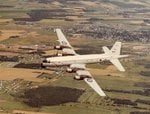syscom3
Pacific Historian
Theres nothing to decide.
The Lanc was a design from the 30's.
The B29 was a bomber incorporating lots of lessons learned. to become a true "weapons system".
The Lanc was a design from the 30's.
The B29 was a bomber incorporating lots of lessons learned. to become a true "weapons system".


